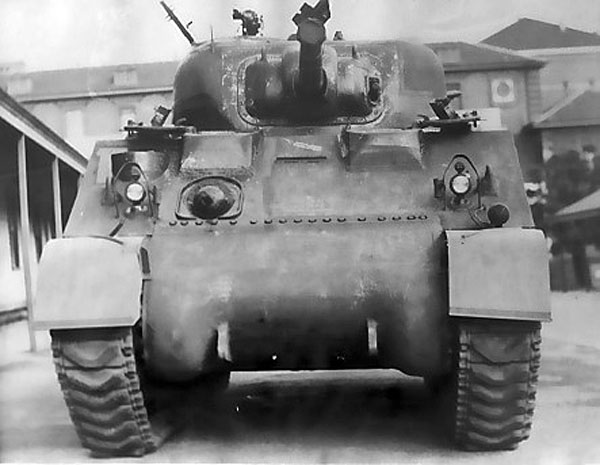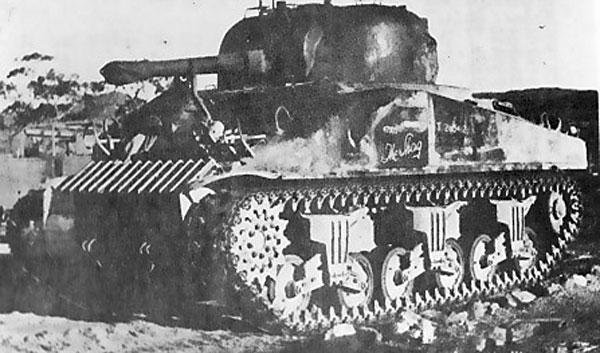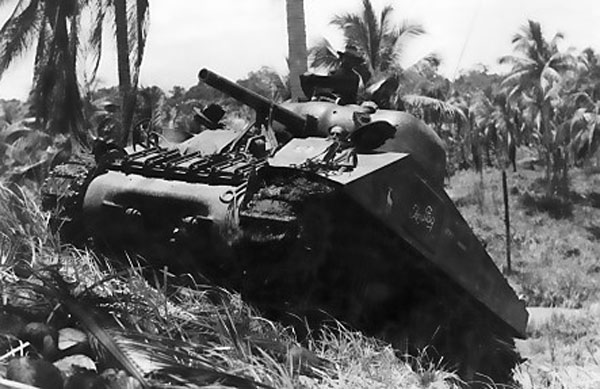|
Shermans Down Under
by Paul D. Handel
IntroductionAlthough Australia received some 757 M3 Medium Grants and Lees during 1942, only three M4 medium tanks were allocated to the Australian Army during the course of the Second World War. The indigenous tank programme, which produced the Australian Cruiser Tank, was halted in mid 1943 after only 66 production vehicles were built. Part of the reason for stopping the Australian - built tank project was the insistence by US authorities of the availability of M4 Mediums in any quantity required by Australia. Indeed, the local manufacture of US Medium Tanks was considered at one stage, but the requirement to obtain power plants from the USA and the inability of Australian industry to produce a synchromesh gearbox were factors which led to the idea being dropped.
|
|
|
|
The M4A2, after repainting in Australian camouflage, on test at Monegeetta. The Australian number can be seen on the transmission housing, along with the bridge classification sign. |
These trials included testing over grass, in bushland, through mud and over standard "WD" obstacles such as step, trench and incline. The vehicle probably remained in the Melbourne area until around the middle of 1944.
![]()
War Office Supplies Tanks
Early in 1944, the Australian Army was requested by the British War
Office to undertake trials of Churchill and Sherman tanks in "New Guinea
conditions". The vehicles would be supplied by the UK, as would RAC and
REME members to assist with instruction on driving and maintenance. The
British allocated two Shermans to the trials, and these tanks arrived in
Australia in May 1944. It is believed the tanks were supplied from
stocks in the UK. Although both tanks bore consecutive British
registration numbers, they were externally significantly different.
Tank No. T263412, an M4 manufactured by the Chrysler Corporation (serial
No. 59427), had a welded rear hull with cast front. It had rubber
chevron tracks, solid bogie wheels, early style sprocket and solid
idler. The gun was mounted in an M34A1 Gun Mount, and the turret had a
loader's hatch. Applique plates were welded on the hull sides. This tank
carried the name “The Stag” during the jungle trials
|
|
|
The M4 (composite hull) at MEE Monegeetta. The name “The Shag” has been applied to the left hand appliqué armour plate. Grouser racks are fitted to the front of the tank, and the rubber chevron tracks are fitted. |
The second tank, also an M4, was registered T263413, and was
manufactured by Baldwin Locomotive (serial 16239). It had a fully welded
hull, with rubber flat block tracks, spoked bogie wheels, late style
sprocket and solid idler. The gun was mounted in a M34A1 gun mount.
Applique plates were welded in front of the drivers' hatches and on the
hull sides. “The Shag” was the name given to this tank.
|
|
|
The M4 at MEE Monegeetta. The name “The Stag” has been applied to the left hand appliqué armour plate. Grouser racks are fitted to the front of the tank, and its flat block rubber tracks are in evidence. |
An interesting sideline in designations is that in both official reports
of the jungle trials the two tanks are listed as M4A1. Not until a
further Australian report of 1945 does the designation M4 appear.
Prior to the New Guinea trials. a series of trials were conducted in
Queensland by 4th Armoured Brigade, with the Shermans being tested
alongside Matildas and Grants.
![]()
Trials in New Guinea
The Australian Army proposed the use of the diesel-engined M4A2 in
the trials as well as the War Office supplied tanks and so the three
Shermans, together with three Churchills (a Mk IV, Mk V and a Mk VII),
were shipped to New Guinea in August 1944 on the US Liberty Ship Norman
J. Coleman, along with 26 Matildas allocated to the 2/4th Australian
Armoured Regiment. After landing at Madang, the tanks were stored in the
open for 14 days, during which time the trials camp was established. The
terrain selected for the trials included plantations of light
undergrowth, with ground surface mud up to 3 feet deep; undulating Kunai
grass, dense secondary growth and creek crossings 18 feet wide and up to
10 feet deep. Rain for the trials period was over 12 inches per month.
Initial running of the Shermans showed that the performance of the M4A2
fitted with steel chevron tracks was unsatisfactory, and so after 57
miles of running for trials purposes this tank was deleted from the
trials. Instead it was used to carry observers around and as transport
to and from the trials site. The track problem was noted in the report
which quoted "…. had this tank been fitted with a flat rubber track and
grousers, its performance would have been superior to that of the
Sherman M4A1 (sic)."
|
|
|
The M4 with flat rubber block tracks moving up a grass covered embankment. Grousers have been fitted to the tracks but there are still some in the grouser rack on the hull front. |
The trials were conducted only in first and second gears, and this
caused some problems with the two M4’s due to the oiling up of spark
plugs. The average distance covered by each tank during the trials,
which lasted 32 days, was 130 miles.
It was considered by the trials team that overall the Churchill was
preferable to the Sherman for operations in jungle terrain. The main
advantages of the Churchill over the Sherman were listed as:
-
Superior maneuverability, especially at low speeds.
-
More suitable low gear ratio for low speed running during infantry co-operation.
-
Greater armour thickness.
-
Marginally better performance when crossing creeks and during hill climbing.
-
Greater ground clearance.
The Sherman was judged to be superior only in the areas of visibility, due to its larger periscopes which had wider fields of vision, and its ability to steer more easily on side slopes. However, the inherent reliability of the Sherman was considered advantageous.
![]()
Return from New Guinea
Following the trials, the tanks remained in New Guinea for a further
three and a half months, after which they were returned to Australia,
where some further trials were conducted. Those trials confirmed the
results of the New Guinea tests, and so the Australian Government
ordered 510 Churchills for the Army. This order was cancelled at the end
of the war, after only 51 Churchills had been received.
After the war, the three Shermans were sent to the AFV school at
Puckapunyal, where the M4A2 and M4 (Composite Hull) were retained. The
M4 was apparently used as a tank target, and was shot up on the range.
The M4 (Composite hull) was used as a small arms target in running
order, as extra armour protection was welded around the entry hatches
and over the air cleaners at the rear.
Later the composite hull vehicle was sent to the Officer Cadet School at
Portsea as a gate guard. It was named Casper and it was reported that
the morale of the officer cadets could be judged by the position of the
main armament. The M4A2 and M4 (composite hull) can both be seen today
on display at the RAAC Tank Museum at Puckapunyal. The turret of the M4
was rescued from the range by Long time military vehicle collector John
Belfield.
![]()
Sources
The original trials reports provided much of the information for this
article as well as most of the photos. The Military History Section
photos taken during the trials can been seen in the collection of the
Australian War Memorial. Some of these appear in the Trials Reports.
AWM Photos Collection numbers include:
51956 -51957 – M4A2 in Melbourne.
68053 -68100 – Queensland Trials
82688 – 82691 – New Guinea Trials
![]()
Shermans Down Under Photo Album
Click
the thumbnails in the table below to view the images full size.
Use your browser's "back" arrow to return to this page.
![]()
Article Text Copyright ©
2007 by Paul D.
Handel
Page Created 25 January, 2007
Last Updated 25 January, 2007
Back to Anzac Steel Main Page







